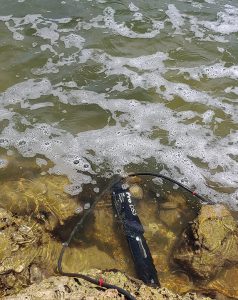Events over the weekend throughout Biscayne Bay brought some sparks of hope. The Pelican Harbor Seabird Station (PHSS) took it upon themselves to purchase their own sump pump, to add to the aerators working in their basin area. Since doing this, it seems like conditions have continued to improve ever so slightly. PHSS Director Christopher Boykin stated that on Friday morning, they only found seven dead stingrays, instead of higher numbers as they had feared. However, green, turbid water that came in during high tide signaled that perhaps there is something else going on. The levels of dissolved oxygen at three different points around the Station show the same pattern: dissolved oxygen remains higher at the surface than at the bottom.

Over the weekend, other rescue efforts were underway. Miami Waterkeeper coordinated fish cleanup efforts. As the dead fish begin to decay, they contribute bacteria into the water, which can cause a cyclical effect. For this reason, it was imperative to safety remove as much of the decomposing fish as possible. Waterkeeper worked with the City of Miami Government and Fertile Earth Worm Farm to provide composting locations for the dead fish. Currently, the compost drop off locations are:
- Morningside Park, 750 NE 55th Terrace, Miami, FL 33137, bins located by the boat ramp.
- Albert Pallot Park, NE 6th Ave, Miami, 33137, bins located by the water.
- Margaret Pace Park, 1745 N Bayshore Dr., Miami, 33132, bins located along the sidewalk.
Note: when dropping off the fish, please empty the contents of your trash bag into the correct compost bin, and throw your trash bag away in a trash can. The compost bins are solely for fish and biohazard (aka biological remains).
Miami-Dade County Fire Rescue boats out of Port Miami sprayed Bay water through their hoses to try and oxygenate some of the lowest-level areas. The FIU Institute of Environment is monitoring these areas to determine if this approach will be effective in raising dissolved oxygen levels.
Additionally, Waterkeeper and City of Miami arranged for the installation of aeration pumps at some of the more highly impacted areas: Margaret Pace Park, Albert Pallot Park, and Morningside Park.
As of today, more fish kills have been reported, and it appears that the event is moving northward. The furthest report to the north is in Little Arch Creek, close to NE 126th Street. The potential multiple factors that could lead to such an intense fish kill make it challenging for resource managers. In addition to dissolved oxygen measurements at several sites, the multi-agency response is looking into bacteria levels, nutrient inputs, rain events, seagrass health, and other parameters.
If you would like to get involved in the cleanup efforts, please contact hello@miamiwaterkeeper.org. If you observe a fish kill or a group of fish gasping for air near the surface, please take photos, note the date, time, and location, and email to: hello@miamiwaterkeeper.org.
 0
0
